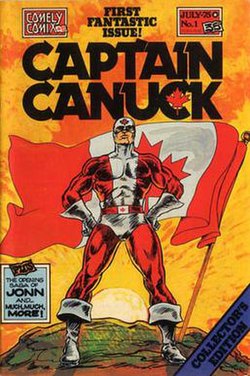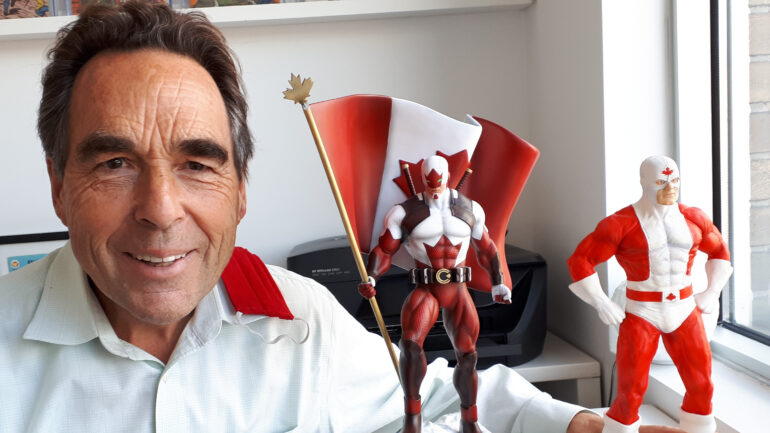For decades Canadians followed the exploits of Superman, Batman, Spider-Man and other American comic book heroes. But Richard Comely, the co-creator of Captain Canuck, knew the country was yearning to have its own superhero.
“When putting the character together I wanted him to be a little more Canadian, a little more humble and not so flashy, loud or boisterous,” Comely said. “I wanted him to become a symbol.”

Comely was never interested in comic books growing up, it wasn’t until he met Ron Leishman in 1970 while attending Red River College in Winnipeg, that everything changed.
“I remember seeing him in the halls and then about probably a year or so later I met him again at church and we became friends,” Comely said. “He was the one who put the idea into my head.”
The two would go on to conceptualize Captain Canuck, a character who’d go on to be the first Canadian comic hero success story since the Second World War.
The War Exchange Conservation Act had banned the importation of non-essential items from the U.S., including comics, and it was lifted in 1946. But the 1947 Emergency Exchange Conservation Act did the same and lasted until 1951.
The second had Canadian printers cashing in by republishing American comics and Canadian comic heroes — including Johnny Canuck and Nelvanna of the Northern Lights — vanished into history.
“For two years at least It was just something we talked about but around 1973 It started to get serious,” Comely said.
Leishman soon departed for a missionary trip for the Church of Jesus Christ of Latter-Day Saints, so It was up to Comely to take the helm.
With a $7,000 loan he took out with his parents’ co-signing, Comely began his work. In 1975 he self-published the first issue of Captain Canuck under Comely Comix.
“I think in many ways, I was somewhat fortunate,” he said. “The first three issues, the print run was 200,000 copies, and distribution was across Canada, even in select states in the United States. Sales were very good.”
Captain Canuck has gone through numerous runs throughout his history and failed to establish itself as a powerhouse in the industry but for Comely looking back on his more than 40 years with the character, there is one story that stands out.
“We got a letter from a kid when the Montreal Expos came into existence. He said now we’ve got our own baseball team and we’ve got our own superhero, and now it feels more like a real country,” Comely said. “That was pretty neat for me.”
One of those kids looking up to Captain Canuck was Martin Boruta.
“Captain Canuck was the first time I ever encountered a Canadian comic book hero and being a fiercely patriotic Canadian that really struck a chord with me at a young age,” he said.

Boruta is the co-owner of Shaw Computer Systems Inc. based in Peterborough, Ont., and is an active member of the Canadian Comic Book Alliance.
“I’ve always had a soft spot for the character. always supported the character whenever it got re-launches and I wish nothing but success for the character,” he said.
Boruta, like many other Captain Canuck fans, wishes to see more consistent monthly issues published as the character’s longest run to date was only 15 issues from 1975 to 1981.
“We’d love to see this character on a monthly basis, to see films, TV shows, action figures, you know, so it is a little bit frustrating that he hasn’t caught on overall in the North American pop culture scene, but he’s still very, very dear to our hearts,” he said.
Brendan Montgomery, founder and editor-in-chief at Sequential Magazine, finds himself pulled into indie comics and away from the classic superheroes like Captain Canuck.
“I was following along the latest relaunch of Captain Canuck and it had great ideas but the publishing output was too inconsistent,” Montgomery said. “But in general with superhero comics in general, once you’ve read so many of them, it’s not new or interesting.”
He points to the versatility of a series such as “The Pitiful Human-lizard: Far from Legendary” by Toronto-based artist Jason Loo as examples of great Canadian indie comics.
“I was looking for ways to help grow the Canadian comic book community without being a creator myself so I began talking with a few creators and one of them gave me the idea,” Montgomery said. “I just ran with it.“
Running an independent magazine has been difficult for Montgomery but his belief in supporting Canadian talent drives him to move forward. He sees a direct battle for readers with the titans of DC and Marvel to be rather pointless.
“The market is kind of cornered by those guys, I don’t know if we even need our own Canadian superheroes,” Montgomery said. “It would be nice to have a few around but the focus is shifting to smaller indie stories that are moving away from Canadian superheroes.”

